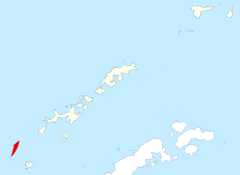Smith Island: Difference between revisions
No edit summary |
|||
| Line 19: | Line 19: | ||
==Outside links== | ==Outside links== | ||
*{{ | *{{basgaz}} | ||
==References== | ==References== | ||
Latest revision as of 16:28, 4 December 2022
| Smith Island | |
| Location | |
| Location: | 63°0’0"S, 62°30’0"W |
| Highest point: | Mount Foster, 6,906 feet |
| Data | |
Smith Island is an island 20 miles long and 5 miles wide in the South Shetland Islands, part of the British Antarctic Territory. It lies 45 miles west of Deception Island.
The island's surface area is 57 square miles.[1]
The island is named after Captain William Smith, who first discovered the South Shetland Islands in 1819. This island was known to both American and British sealers as early as 1820, and the name Smith has been well established in international usage for over 100 years, although in Russian literature it is often referred to as Borodino Island, sometimes marked as Borodino (Smith) Island, from the name given to it by Bellinghausen.

The island hosts no research stations or camps, and is seldom visited by scientists or mountaineers. Its interior is entirely occupied by Imeon Range rising to 6,906 feet (Mount Foster). The first detailed topographic mapping of the island was made by the Antarctic Place-names Commission and the Military Topographic Service of the Bulgarian Army and published in 2009[1] in both English and Bulgarian.
Outside links
- Gazetteer and Map of The British Antarctic Territory: Smith Island
References
- ↑ 1.0 1.1 L.L. Ivanov. Antarctica: Livingston Island and Greenwich, Robert, Snow and Smith Islands. Scale 1:120000 topographic map. Troyan: Manfred Wörner Foundation, 2009. ISBN 978-954-92032-6-4
Coordinates: 63°00′S 62°30′W / 63°S 62.5°W
| The South Shetland Islands, British Antarctic Territory |
|---|
|
Bridgeman • Clarence • Cornwallis • Craggy • Deception • Elephant • Gibbs • Greenwich • Half Moon • Heywood • King George • Livingston • Low • Nelson • Penguin • Robert • Rowett • Rugged • Smith • Snow |
